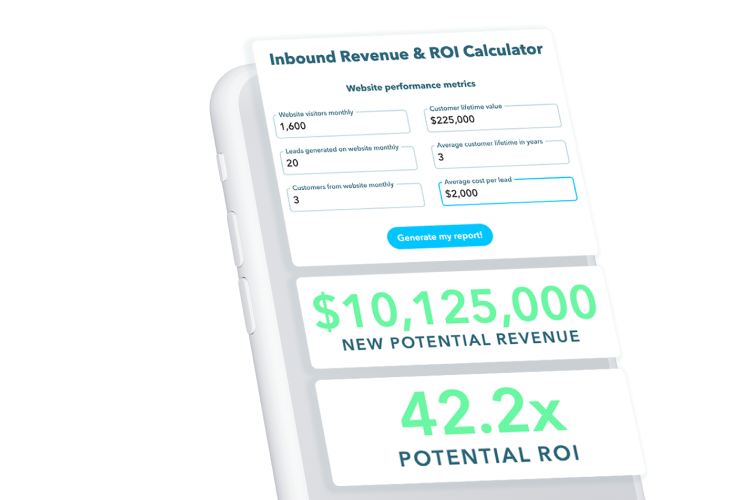 691 views
691 views 3464 Views
3464 Views  22 min read
22 min readIn this digital era, where more and more people work and buy online, from the comfort of their own home, competing for the attention and trust of your audience online is no easy task. In recent years it’s become increasingly critical for businesses to engage with their audience to gain loyal customers.
Leveraging a blog is at the center of that battle, yet it raises a lot of questions for business owners and management. Given the complexity and number of factors that influence the success of a business blog, knowing what you can and can’t expect from blog content is extremely challenging.
There are a LOT of misconceptions and myths out there about how blogging magically generates explosive traffic and leads in no time at all. We believe you deserve transparency and straight talk at Responsify. That’s why we’ve combined over 7 years of client statistics and additional verified sources to provide you with this research, knowledge, and an actionable estimation tool to know what you should expect your business blog to do based on where you are and how you do it for your company.
Before we dive in to the specifics of how blogging for business works and what you can expect from it, here are a few stats to keep in mind about why starting a company blog can have a positive impact:
Statistics about the benefits of blogging for business:
53.3% of all website traffic comes from organic search.
This figure represents an increase in share of website traffic since 2014.
In a poll among Twitter users, 49% of Search Engine Journal followers said organic search had the largest ROI among digital marketing channels.
Marketing professionals see the long-term value in driving traffic to their site through search.
Companies with blogs produce an average of 67% more leads monthly than companies that don’t blog.
The majority of B2B companies who blog do so to increase their lead generation.
Leads have a 14.6% close rate with an inbound marketing strategy, as opposed to a 1.7% close rate for leads generated via outbound efforts like paid ads or cold calls.
When a potential customer comes to your blog organically, chances are high that your page was recommended in search as an answer to their question. Connecting with potential customers who actively need a solution leads to higher conversion rates, and your blog is where that work happens.
Roughly 60% of marketers stated Content Marketing is ‘very important’ or ‘extremely important’ to their overall strategy.
If you’re not creating blog content for your business, you are missing a critical piece of marketing strategy.
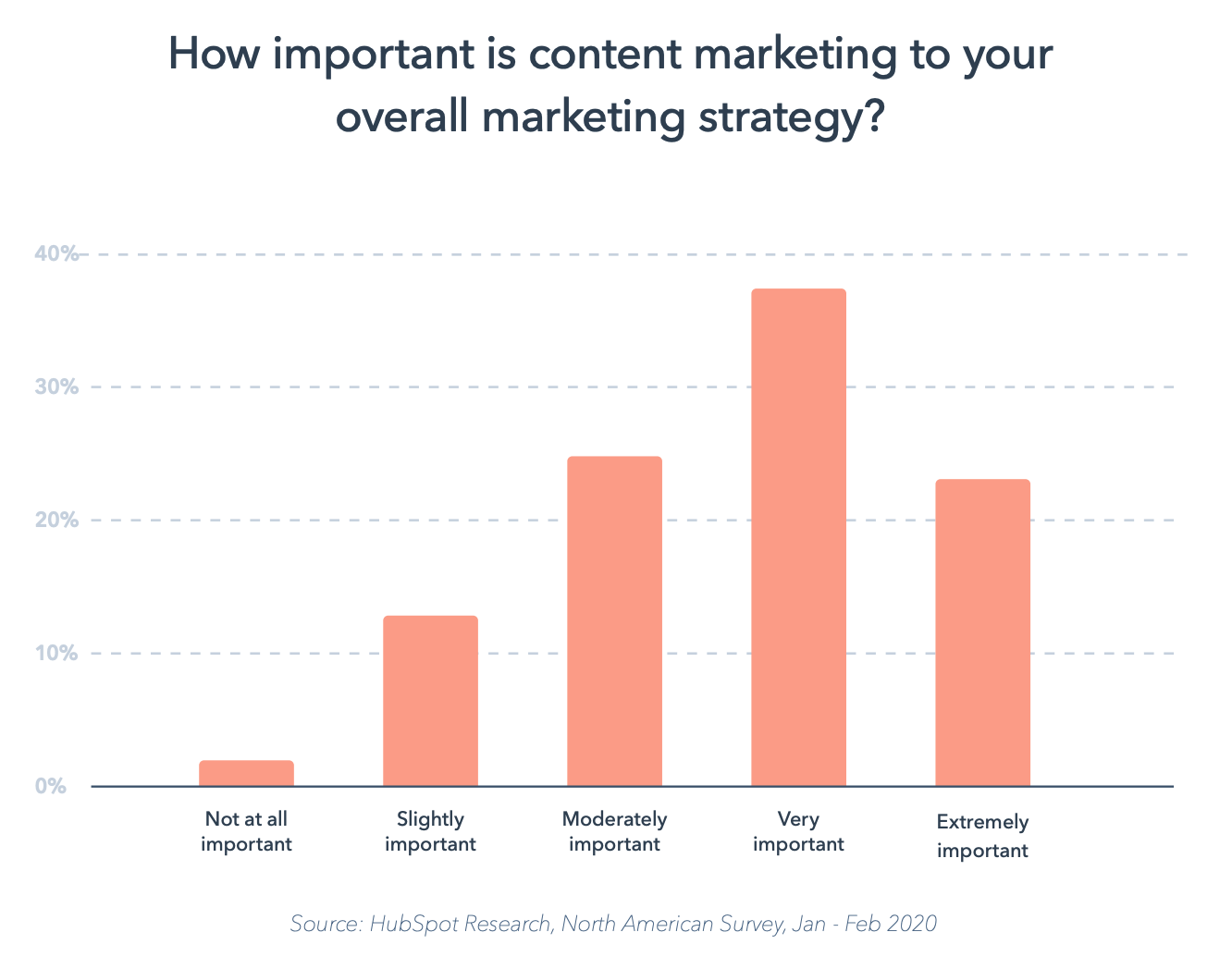
As we mentioned, having a digital presence is more important today than ever, but competition is fierce. Many companies start their blog, but never get their content off the ground. But you don’t need to be a content marketing machine to see growth. We’re not going to give you “hacks” to help you get your blog started, instead we’ll present the knowledge and tips we’ve developed from building our clients’ blogs, and have developed a tried and tested strategy around our experience and the experience of other experts in our industry.
Read More: The Secret to Creating a Successful Business Blog in 2021
As you set out to grow your business through blogging, there are questions you’ll need to answer in the beginning to optimize your website and prepare your business blogging strategy. Do you have your audience clearly defined? Do you know what your audience truly wants to read? Do you know what your audience is searching for online? Do you have the resources to do what’s needed for your blog to succeed? These are just a small handful of important questions that need to be answered if you want to see the most growth from your blog.
Before you see lead generation through your blog, it is important to focus on growing traffic to your blog. Below we’ve listed the core components we follow to blog effectively for growth.
Before pen ever touches paper (or cursor to pixels), you’ll need to understand who you want to write for. As generating traffic and leads is the main motivation for many businesses starting a blog, it’s implied that your audience is your customers. But how well do you actually know the factors driving their desire to purchase?
To understand your audience, there are a number of exercises you should perform to know exactly who to write for.
Identify the unique characteristics of your industry by segmenting your market by audience– this will make it better to target your message to them. The more specific your blogging message, the more real-life questions you can answer for your audience, which will earn their trust in your business.
Segmenting your market may uncover untapped topic areas your competitors don’t write about. We will discuss why this is important when we talk about insights in the section below.
If you have customers already, we recommend taking an in-depth look at why those customers bought from you. Conduct interviews with existing customers to get valuable insights into the customer’s frame of mind when they purchased from you: their motivation to buy, their frustrations, and how they view your business. Hearing about the buyer journey from real-life buyers gives you an idea of how to tailor your messaging to address their problems.
Personas are fictional depictions meant to represent one or more of your ideal customers. Personas are built using a combination of real facts about existing customers, and research completed regarding your ideal customer base. Writing out descriptions of personas and their challenges, goals and responsibilities creates a very specific target for your messaging.
As you learn the specific desires of your audience, further research is necessary to understand your company’s position relative to competitors and in the digital space in general.
Analyzing your competitors’ digital presence is good for gaining an understanding of what marketing methods work in your industry. It also is an opportunity to identify blog topics that your competitors don’t cover that you can leverage to your advantage in driving traffic to your site.
Attracting organic traffic from search engines is an important part of your strategy for long term growth. A keyword is a word or string or words that users commonly enter into search engines. Search engines return results with posts that most closely match the keyword. (We’ll get into how you can rank better when we talk about Domain Authority below).
When gathering insights, completing in-depth keyword research based on persona topics allows you to see which keywords are oversaturated with content (making it harder to show up in search for those keywords) and which are not as competitive. Finding keywords that have low competition but high to moderate search averages present good opportunities for blog topics.
Once research is complete, compile these keywords into a list to use as the basis for blog post topics when you start writing.
If you’ve produced content before, what worked? What topics got the highest amount of inbound traffic and why? Knowing the metrics of your old blog can help you set benchmarks for future performance, and may help identify any topics of interest for your current audience.
Once you have an understanding of your audience and industry, it’s time to create your content strategy. It’s most important at this stage that you tune out calls from your sales department to pack each post with features about your product and instead create a strategy that meets audience expectations.
Statistics about how to get traffic to your blog:
In a survey by the content marketing institute, 88% of the most successful content marketers said their organization prioritizes an audience’s informational needs over the organization’s sales message.
Messaging is important, and people come to your site at different stages in the sales process. Only creating content that tries to sell will keep your audience from connecting with your business.
Only 3% of your target audience is ready to purchase at any time.
Creating blog content that is exclusively sales pitches for your product will turn away 97% of readers.
Before someone is willing to buy from you, you first want to make them aware they have a problem–and that means refraining from giving them your sales pitch in every single blog. Instead, create strategic content tailored to your audience in different phases of the sales journey.
A Google+ consumer insights report in July 2020 coined the term “the messy middle” to describe decisions to buy made in the middle of the purchase journey. The article explains two mental modes–exploration and evaluation–that people can loop through many times before making a purchase decision. The important takeaway is to tailor your communication to people in this phase by giving them the message they want to hear, not what you want to sell them.
It is especially important that businesses new to blogging focus on building brand awareness and tailoring messages to their audience’s needs at the start of content creation.
Read More: Best Growth Strategies for B2B Tech Companies
Once the strategy is set, it’s time to focus on creating good content. The content you create for your blog is what will grow your audience and business over time. The key to business blogging, especially at the start of content production, is to find a balance between the quantity and quality of content you produce. Following the steps below will help to set up a repeatable action plan to create high quality blog posts.
You want a writer who has experience writing high quality and compelling articles that capture the reader’s attention and create engaging content for your audience.
Work with a writer who has experience writing for your industry to get the most out of your blog posts. An experienced writer can create unique content that presents a subject for your industry in a new way. Presenting new ideas and refraining from repeating the same industry catchphrases will make your blog stand out to your audience.
Take the list you compiled at the end of your keyword research, focusing first on the keywords with low competition but high search density. Keywords in this list are good candidates for blog post topics.
Each blog post you create should center around one keyword, with the keyword repeated occasionally throughout the body of the text. Be sure the addition of the keyword feels natural to read; if your blog post is packed with keywords without attention paid to the quality of the writing, readers will click away quickly, telling search engines to rank the post lower.
When writing, you want to craft the message of your post to address an identified need of one of the personas defined early in this process. The more specific you can make your message, the better. Writing to a persona creates a blog post that is specific instead of broad; meaning the piece will connect with readers who fit into that persona group.
As a general rule when producing content, you should want your content on a whole to be broadly specific. Meaning that each blog post is specific on an individual post level, then as you build out collections of posts around different subject groups, the expertise written specifically in each subject area will back up the assertion of your broad industry knowledge.
Search engines also track how consistent your posting schedule is. Businesses that produce content consistently and continue to do so over a long period of time will rank higher than others who post on a sporadic schedule. For companies just starting to build brand awareness through content marketing, a good benchmark is to aim to publish 1-2 posts per week.
Even while you’re working to create content, it’s important that you don’t overlook the role the backend of your website has in bringing traffic to your site.
Using a CMS (Content Management System) allows you to organize your content and linking structure. Over time, as the number of posts in your site increases, using a CMS makes it easier to organize and categorize posts.
With a CMS you can easily edit an older piece of content, update for relevance or add new links to improve your site linking structure. Working with a CMS also makes it easier to optimize your content for on-page SEO.
SEO (Search Engine Optimization) has become a broad term in content marketing. Some sites will claim to offer “5 SEO hacks to boost your ranking,” but while there may be some simple changes you can make to improve your site, the most effective strategy is pairing good SEO practices with the content strategy items listed above. In this example, when we say on-page SEO we mean changes you can make within the content of your blog post or on the post page in your CMS.
The first piece of optimizing on-page SEO is keyword optimization. Double-check each blog post has one main keyword as the topic, and that the keyword is used naturally throughout the post. When it comes time to add this post into your CMS, you also want to include the keyword in other areas of the webpage: areas like the title, page URL, and image alt text.
Link structure is also important. There is more we will get into about links in the section on domain authority below, but it is important that your site have an organized, hierarchical link structure, and that the structure is also represented in your URLs. Using a CMS platform with your site will help create this much-needed hierarchy.
Alongside the steps above, it’s critical to strengthen your search engine ranking power known as Domain Authority. Domain Authority is a metric score created by Moz, that indicates the amount of authority your website has on a scale of 1 to 100, known also as “DA”. Your DA in comparison to another website’s DA is a strong indicator of how easy or hard it would be for your blog posts (web pages) to rank on search engines like Google.
For example, when searching Google for “benefits of employee training software”, the following graphic shows 7 pages of search results. Scrolling down on page 1 of the search results, a blog post called “Benefits of Employee Training Tracking Software” is listed from a website called powerdms.com. On page 7 of the search, a blog post with the name “Only 5 Employee Training Software You Need to Know About!” is listed from a website called kitaboo.com. Both blog articles have almost identical number of words, writing quality, links, etc. however one is listed on page 1 and one on page 7. This is in large part due to the credibility, or “edge”, that powerdms.com has over kitaboo.com with Google. This can be seen when comparing their website’s Domain Authority, as powerdms.com has a DA of 45, and kitaboo.com has a DA of 39. Even with this seemingly small difference in their DA scores, powerdms.com gets its blog post listed on Google’s coveted page 1. It’s not magic, it’s Domain Authority.
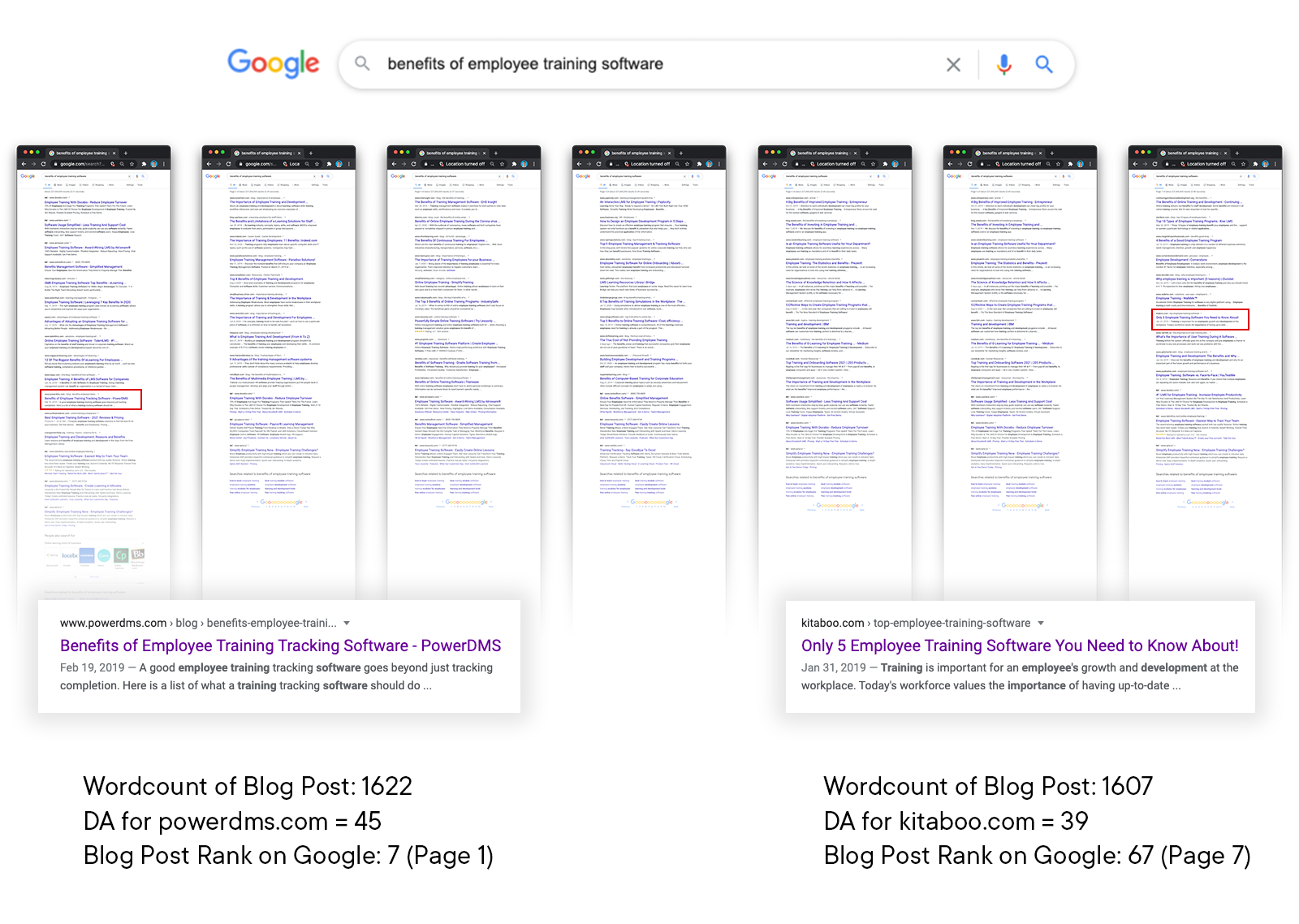
When building DA, you cannot overlook the importance of links. One of the most important contributors to a high DA is the number of backlinks to your site. Backlinks (also called inbound links) are links on other sites that point back to your site.
A site with more backlinks has a higher DA. Having a higher DA is like having a higher amount of popularity, because more people (websites with authority) have linked to a site. If other sites are linking to you, that implies they like and trust the content you create, which further implies that other readers will like and trust your content. In addition, if a site that backlinks you has a higher DA than you, that can have a greater impact on your own site’s DA.
Here are other important factors used to determine DA:
Improving DA is no minor task. Before your DA can improve, you must focus time and resources into content creation and building a well-designed site. Once you’ve got a good foundation of content on your site, these are the factors that improve DA that you can focus on:
If it seems a bit abstract, that’s because it is. Remember, Google is a business whose goal is to give users a better search experience than its competitors can. The exact factors that determine the success of your blog in the search rankings are proprietary. Services like Moz’s DA score can (successfully) guess at what factors contribute to higher rankings, but nothing is exact.
And DA is not the end-all, be-all score that determines the success of your blog. DA is important, but when used correctly, your goal should be to improve your DA relative to your direct competitors’ scores. If your competitor has a score of 40 and your site has a score of 50, you will consistently rank higher in searches when writing about similar subjects. Aiming for a high score just for the number itself is unrealistic for an industry blog, because the sites with the highest DAs are sites like Amazon and Wikipedia due to their massive link structures.
As the saying “Rising tides lifts all boats” goes, the stronger Domain Authority your website has the higher each blog post and web page will rise in Google’s rankings. Combining this with great strategy, excellent content, and an optimized website will lead to better rankings and set your business up for long-term success.
Einstein said it best when he stated “It’s all relative”, but maybe that’s not the answer you want to hear when you ask, “how many blog posts before traffic?” But there are a number of factors that vary from industry to industry that determine the rate of traffic growth. What is your website’s Domain Authority compared to your competitors? How many of them have produced content, and how much? How competitive are the keyword topics your business blog needs to focus on and rank for?
The answer to these questions helps determine in relative terms how many high quality blog posts you need to increase traffic. The short answer is only the “Google Gods” know; no human being can predict the exact number of blog posts it takes for you to see a specific amount of traffic.
From our experience at Responsify, there’s a range of traffic generation resulting from blogging.
In the “Starting from zero” scenario:
At the lower end of results we’ve seen for a client who started a new website with a Domain Authority of 1, gained 51 visitors per month from organic search as the 12th post was deployed, building up to 289 visitors per month as the 24th blog post was published. Over 12 months after first publishing, traffic generated through organic search alone increased to be the source of 89% of all traffic to their site.
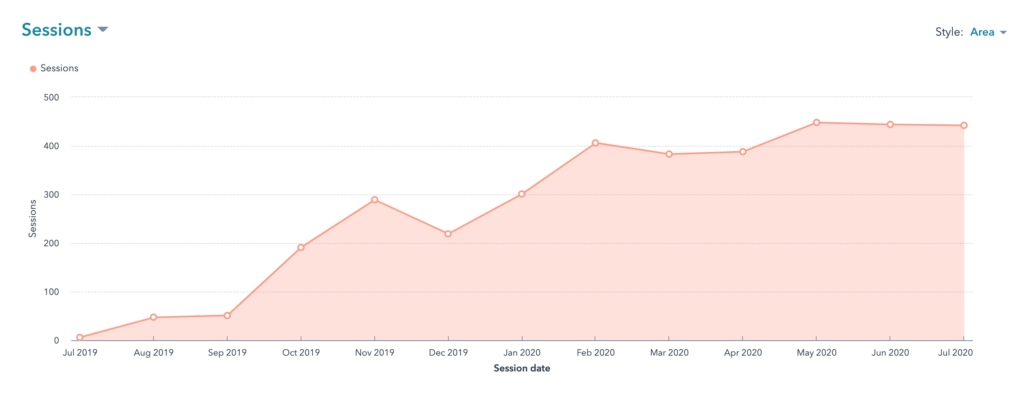
With the “Wind at our backs” scenario:
At the higher end of the results we’ve seen for a client who had an established website with a Domain Authority of 24, rose to an average 787 visitors a month via organic traffic after the 12th post was deployed, building up to just under 1000 visitors per month as the 72nd blog post was published.
These are the results from only two of our clients, we’ve found more examples to set a benchmark goal in the number of posts you can expect before seeing a growth of traffic:
Statistics about how many blog posts before traffic:
Companies looking to increase organic traffic should aim to publish 3-4 posts/week for small blogs, and 4-5 posts/week for large blogs.
Search engines favor sites with a large amount of content published consistently over time.
Companies with 400 or more blog posts saw a doubling of traffic to their site after passing the 400th blog post mark.
Think of 400+ blog posts as the critical mass where growth explodes from traffic. Companies who reach this mark are likely to be at least a year old and have a consistent publishing schedule, two factors search engines highly value in rankings.
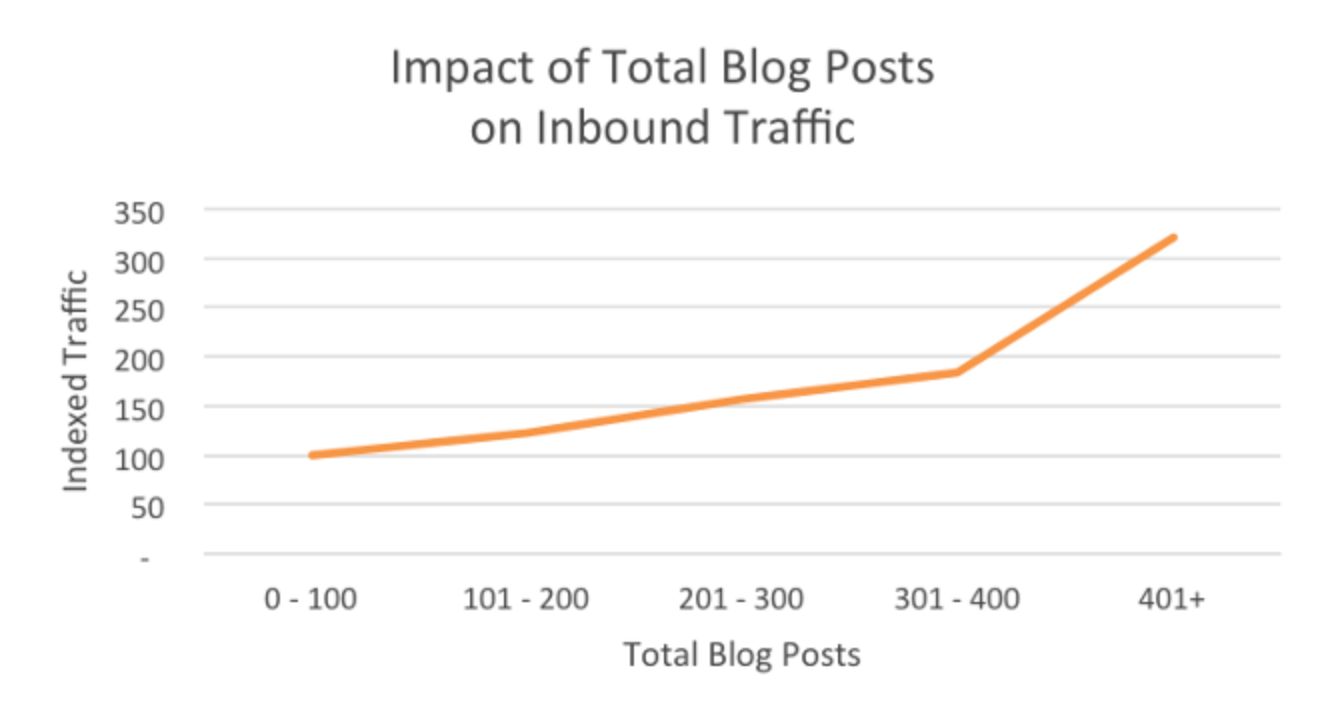
Seeing a consistent increase in traffic after 70 blog posts, The Weidert Group recommends “The best strategy is to reach that 55-70 total blog article range as quickly as you can with high-quality content and consistent publishing schedule.”
Blogs starting with 0 posts should aim for the 70 post benchmark first.
It commonly takes between 6-12 months after content is first published (not from the start of developing your strategy) to see the results from your blog. When getting started, it’s important to be honest in your evaluation of the current state of your business blog. Using the scenarios discussed earlier, are you starting from zero, or is there some wind at your back from previous marketing efforts?
This honest assessment at the start will help you set realistic metrics to measure the success of your first 6-12 months blogging. But regardless of your starting point, you can expect to see positive traction in an increase of organic traffic around the 6th month mark.
But this number isn’t validated by our data alone, leading sources on business blogging also agree that in most cases growth realistically first begins around at least the 6 month mark and sometimes at the 12+ month mark:
Statistics about how long does it take to see results from a blog:
It takes 3-6 months for a new blog to get indexed in search engines on average (Daccanomics)
It takes time for search engines to crawl and index your blog so that you can begin seeing traffic from search.
Allow 6 months to start gaining traction from search engines (HubSpot)
Google places a higher value on domains that are older. A lot of blogs get started and abandoned within months of first publishing, so you have to outlast those subpar blogs to see real growth.
It typically takes 4-6 months to see organic traffic when employing a strategy centered around search engine optimization. (Webfx)
Optimizing your blog for search engines can shorten the length of time you have to wait before seeing results.
4-6 months to start seeing results when your strategy focuses on optimizing for search engines (Forbes)
SEO adds another layer of tasks you need to follow, but the payoff comes from seeing traffic earlier than you would without it.
Commonly, blogging for at least 12-18 months is necessary before you can fully assess the effectiveness of the strategy on increasing website traffic and attracting/converting new lead opportunities. (Weidert)
There are factors that make your business and industry unique from others, and these factors affect the exact timeline of traffic growth. Give yourself at least a year or more to see and analyze that traffic.
The key is to remember that when you begin blogging, traffic will not shoot up overnight. It’s easy to see these numbers and hope your blog will be the exception that sees growth earlier than average. But setting that expectation without setting an explicit plan stating how you will achieve faster-than average growth will only set yourself up for disappointment a few months into implementation.
Traffic growth will be slow at first. If you’re starting your blog on a brand-new website, it may take days or even weeks for search engines to notice. Bad traffic numbers in the early months are not a sign that you should quit. Remember, search engines intentionally rank newer sites lower as a means of disincentivizing companies that aren’t committed to providing quality content in the long run.
But if you stick with it, consistently publish past the 12-, 18-, and 24-month marks, and continue to provide fresh content that meets your audience’s needs, you’ll get the return on your investment.
The question “how much does blogging increase traffic,” is often a difficult one to answer. What is the status of your blog now? Do you have old posts in your site that are still generating traffic? If your blog has some old posts already, even if you’re not actively doing anything with them they are still indexed by search engines and generating an amount of traffic.
If you’re starting from scratch with your blog, then technically any growth is an impressive number. But that doesn’t give you a realistic expectation of what you can see from blogging.
And still another factor is your industry itself. How big is the market, and how many of your competitors have an established digital presence that can take away traffic from you? Again, everything is relative and varies depending on your situation, but here are a few case studies we’ve found, including a look at our own metrics:
Statistics on how much does blogging increase traffic:
Having a business blog leads to 55% more visitors on your site.
The more pages on your site, the more pages search engines have to index and offer users as potential entrances to your site.
In one example, using Hubspot’s Blog and SEO tools led to a 200% increase in traffic over the span of 10 months.
Driving growth isn’t magic. We know the strategies that work best: correct implementation and a commitment to the strategy over months of content production.
We saw a 321% increase in a client’s web traffic over the span of 18 months by utilizing strategic blogging.
Following the steps laid out above in defining audience, gathering insights, creating quality content and optimizing for search all played a role that lead to this growth.
In order to know how much blogging increases traffic we need to think in both the short-term and the long-term. In the example screenshot of responsify.com’s traffic analytics shown below, we show the results we earned in the first 3 months of blogging for responsify.com in 2015 (when blogging was far less competitive), as well as over 6 full years. While looking at what we’ve accomplished, keep in mind we went all in and invested heavily in our content strategy and production over the years. As the great Theodore Roosevelt once stated, “Nothing worth having comes easy.”
In our first 3-12 months after aggressively producing and publishing around 30 high quality and strategic blog posts, we gained 114 visitors 1 month after the first batch of ~10 posts published, 302 visitors in the second month with ~20 posts published, and 747 visitors in the third month with ~30 posts.
After 1 year of heavily producing strategic content in our blog, we have nearly DOUBLED our traffic year over year by producing over 100 posts per year! Our Domain Authority has steadily increased to 33 as well.
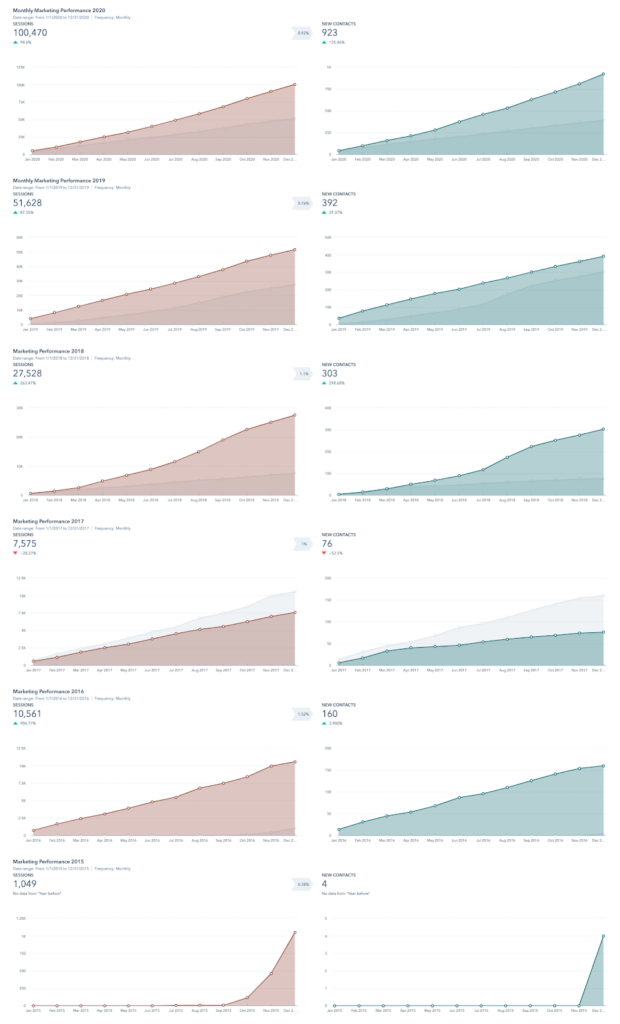
Alongside planning the strategy and schedule for blogging to increase traffic, it is equally as important to have a plan for how you will generate leads with your blog. Some good news for your marketing efforts, building readership of your business blog through the methods outlined above can easily lead to a higher rate of lead conversion if you have strategies in place to capture visitor information.
Statistics on how to generate leads with a blog:
Businesses that blog get 126% more lead growth than businesses that do not blog.
If you’re not blogging, you are losing out on opportunities to grow your customers and your business.
Long-form blog posts generate 9x more leads than short-form blog posts.
Create an opportunity to convert readers into leads by keeping long-form content behind an email submission form<
83.9% of companies using inbound marketing increased their lead generation in 7 months.
Even as you work towards long-term growth, you can still see a small increase in leads as early as 7 months into publishing.
B2B websites with more than 400 published blog posts generated 3x as many leads as B2B companies with 200 or fewer posts.
Going back to that 400 number we talked about earlier, as the volume of posts pulls in more visitors, so will your leads increase.
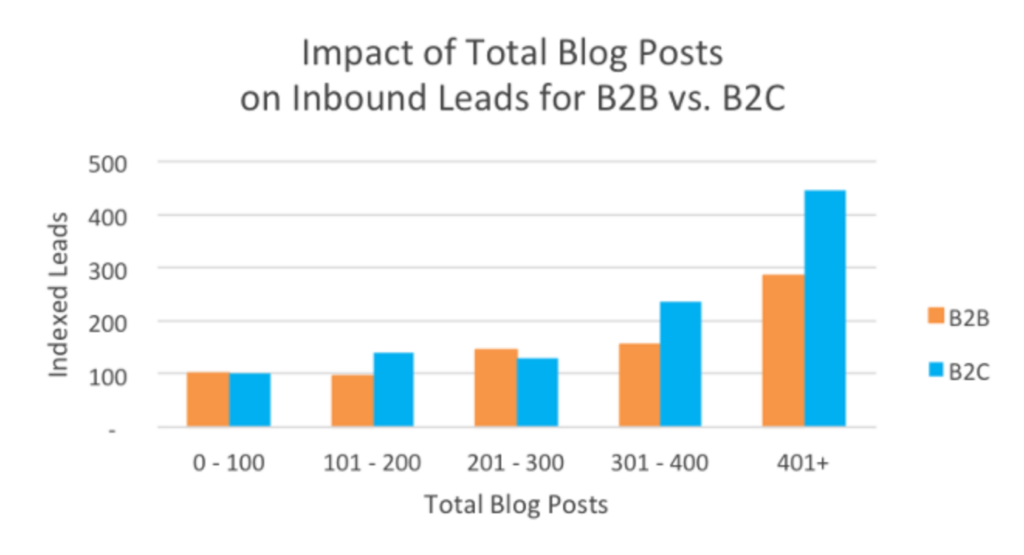
“The biggest determinant of whether a blog post will convert is not the call-to-action (CTA) that you place inside of a post, but rather the idea behind the blog post itself.”
It all comes back to content. What message do your posts convey? Are they all packed with stats about your product, or do they seek to help customers by answering their actual questions? Are you creating content optimized for under-utilized keywords in your industry? If you create content that is helpful before you sell to them, your audience will be more receptive to viewing your business as a potential solution to their problem.
After the work you put into identifying your audience, creating content and optimizing your website for search traffic, it is not enough to sit back and watch the numbers grow. It takes strategic CTAs aligned with your subject matter, and a varied selection of content topics for readers to engage with your site, which will generate leads in turn.
Generating leads also depends on the type of content you create. Blog posts are good for driving organic traffic and building awareness, while content that is more long-form posts like eBooks, guides, infographics and checklists create leads when kept behind an email submission form.
Before you start to put long-form content on your site, it takes reading regular blog content for visitors to determine whether they find the information your business shares as relevant to their needs and worth handing over their email for. So plan to create only blog posts for the first few months, then start producing longer content when your audience will be more receptive to it.
Read more: B2B Lead Generation Content Tactics
But that leaves us with the question, how long will it take to generate leads from blogging? We don’t have a hard and fast rule, but the experts at Fronetics say the same length of time it takes to convert a lead to a customer, is the same length of time you can expect to convert a reader to a lead.
And most marketers agree that the worst thing you can do for lead generation from organic search is to stop content creation altogether, especially too soon. Remember, as discussed earlier in this post consistent content production is the key to building trustworthiness with search engines, which in turn will drive organic traffic and lead generation.
If your business is just starting to blog, you may face a number of challenges at the outset. Challenges can look like anything from a lack of digital presence to pressure from higher-ups to manage marketing budgets wisely, or a desire for quantitative metrics that show immediate and explosive growth after a few months.
We get it. We understand the pressure is on the marketing team to produce growth. Leaders who don’t understand the ins-and-outs of the digital space place a high value on short-term gains, because they don’t know about the potential reward of building for the long term.
Blogging for business growth is the best strategy to employ in your B2B marketing, because it provides a sustainable path to building your audience and growing your company. By building content around your audience’s needs, over time your blog readership will grow, the traffic you receive from search will gain momentum, and it will get easier to generate leads. It’s a strategy that will grow with your business. And as your business gets bigger or expands services, you’ll be ready with a content production strategy in place to address new audience concerns and questions.
The strategic content created in the first year is critical to your success, and will drive traffic to your site for years to come. Having content and a quality website only aids in your business’s digital footprint. And in today’s world that footprint matters, even if not everyone on your team sees it.
So, as you embark on your blogging journey, it is important to manage expectations. Focus the first few months on identifying your audience and setting a research-driven strategy. Find good writers who create quality content, but don’t focus so much on quality that it impacts the speed and consistency of your content production. Even when you get everything right in the beginning, seeing the actual results in terms of growth will take a year or more.
Through all of this, aim not for hard stats, but on hitting your benchmarks of 55-70 posts. Monitor your traffic starting 6 months after publishing to identify topic areas that hit particularly well with your audience. But most importantly, don’t stop producing content. Momentum takes time to build, but once you’ve got it, the growth you’ll see will be well worth the wait.
If it the task seems daunting, you’re not alone. We at Responsify make it easy for businesses to produce strategic content in a cost effective way. If you’d like to discuss your goals with us and get some specific recommendations, feel free to reach out and schedule a complimentary strategy session here with one of our seasoned content strategists. We’re here to help!
Also Read – Blog Marketing: How to Increase Sales, Build Your Brand, Get Results
